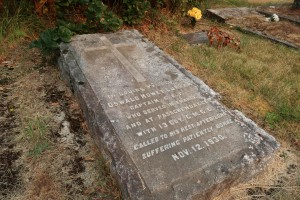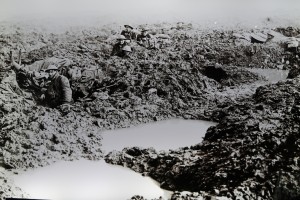The Highway to One Man of Passchendaele
Captain Oswald Howey Lunham, “…for now and all time”
The Highway takes us up the island to our turn to the left…..to a solitary church…..near to a railway bridge…..near to a river.
Sitting at my desk some while back I wrote and re-wrote the words that have become this day’s Passchendaele. A battle whose centennial was recently marked July 31, 2017 – but the words of mine, for that time, did not meet my expectations and so I let them rest until this day when I have traded pen and paper for keyboard and screen. I can reminisce more easily this way winding my way visually and through the keys to our person of interest.
As we meander towards the church with its place of rest I contemplate the phrase we are to encounter. I know not much of our soldier but he is here with one line to remind us all of his Passchendaele. It is his story – a family story – captured for all – and for all time – by one mindful soul’s thought, “CALLED TO HIS REST AFTER LONG / SUFFERING PATIENTLY BORNE / NOV.12.1930.”

Resting Place of Captain O.H. Lunham, Passchendaele Veteran, St. Andrew’s Anglican Church, Cowichan Station, BC. (P Ferguson image, August, 2017)
Captain Oswald Howey Lunham joined the 112th Battalion CEF at Windsor, Nova Scotia. A mine manager, Lunham served in France and Flanders commencing in July 1917 with the 13th Canadian Machine Gun Company. It was 10 November 1917, at Passchendaele, that Oswald Lunham suffered Shell Shock. Though his service record includes lengthy observations of his symptoms, some lines stand out from the others, “He has the appearance of a very neurotic person, and has a cast down expression as if some great sorrow was on his mind…He states he was always of a nervous temperament, but since this shell shock his nervous system seems completely shattered.” (Assistant Director of Medical Service, Military District 6, April 13, 1918, pages 61 and 64)
Evidence of a previous breakdown, ca. 1914, are recorded in medical reports of 1918, however, Oswald Lunham chose to wear the uniform of his Canada. After seven months service in France, it was after two attacks at Passchendaele that Lunham’s system broke down leading to rheumatic fever, a complete nervous breakdown, difficulty in sleeping, difficulty in the company of others, afraid to be left alone in the dark, headaches and depression.
As I continue to read through these reports the repetition of his symptoms bounce again and again from the pages of 1918 to the face of 2017. Our goodly Mr. Lunham’s Passchendaele would remain with him for the rest of his days…and yet I take some comfort from the words of 1918 when I read “He can travel by transport as his wife can accompany him…” and it is perhaps from Myrtle Lunham, his dear wife that chose our thought for now and all time at a solitary church…..near to a railway bridge…..near to a river….
The Trews, Highway of Heroes.
Support the Canadian Hero Fund


Sad. A tear for the Capt & his wife ! Oswald was nearly 34 when he enlisted. His war would last for 14 years ! A time when any support was lacking for our veterans ! This was also Myrtle’s pain to bare ! God Bless !!